Welcome to TensorFlow introductory practical course Code review and summary of MOOC TensorFlow introductory practice course (I) Code review and summary of MOOC TensorFlow introductory practice course (III)
Note:
Used to represent python code
Paste run results
catalogue
- 5 basic application of image classification -- cat and dog classification case
- 5.1 import and stock in
- 5.2 downloading data sets
- 5.3 viewing the number of samples
- 5.4 create a folder to store training and test data
- 5.5 segmentation into training data and test data
- 5.6 model construction
- 5.7 data preprocessing
- 5.8 model training
- 5.9 visualization of training results
- 5.10 model reasoning
- 6. Transfer learning -- a case of human horse classification
- 6.1 downloading data sets
- 6.2 import library
- 6.3 samples shall be classified and stored in the designated folder
- 6.4 read the data of 10 people and horses respectively under the stored directory folder
- 6.5 view the number of samples under the people and horses folder
- 6.6 use matplotlib to display the horse image
- 6.7 network construction and related parameters
- 6.8 data preprocessing
- 6.9 training network
- 6.10 model evaluation
- 6.11 view characteristic diagram
- 7 image multivariate classification -- a case of handwriting recognition
- 8 image multivariate classification -- gesture recognition of scissors, stone and cloth
- 9 natural language processing
- 9 entry and serialization
5 basic application of image classification -- cat and dog classification case
5.1 import and stock in
import os import zipfile import random import tensorflow as tf from tensorflow.keras.optimizers import RMSprop from tensorflow.keras.preprocessing.image import ImageDataGenerator from shutil import copyfile
5.2 downloading data sets
# If the URL doesn't work, visit https://www.microsoft.com/en-us/download/confirmation.aspx?id=54765
# And right click on the 'Download Manually' link to get a new URL to the dataset
# Note: This is a very large dataset and will take time to download
!wget --no-check-certificate \
"https://download.microsoft.com/download/3/E/1/3E1C3F21-ECDB-4869-8368-6DEBA77B919F/kagglecatsanddogs_3367a.zip" \
-O "/tmp/cats-and-dogs.zip"
local_zip = '/tmp/cats-and-dogs.zip'
zip_ref = zipfile.ZipFile(local_zip, 'r')
zip_ref.extractall('/tmp')
zip_ref.close()5.3 viewing the number of samples
print(len(os.listdir('/home/zzr/data/cats-and-dogs/PetImages/Cat/')))
print(len(os.listdir('/home/zzr/data/cats-and-dogs/PetImages/Dog/')))
# Expected Output:
# 12501
# 1250112501 12501
5.4 create a folder to store training and test data
try:
os.mkdir('/home/zzr/data/cats-v-dogs')
os.mkdir('/home/zzr/data/cats-v-dogs/training')
os.mkdir('/home/zzr/data/cats-v-dogs/testing')
os.mkdir('/home/zzr/data/cats-v-dogs/training/cats')
os.mkdir('/home/zzr/data/cats-v-dogs/training/dogs')
os.mkdir('/home/zzr/data/cats-v-dogs/testing/cats')
os.mkdir('/home/zzr/data/cats-v-dogs/testing/dogs')
except OSError:
pass5.5 segmentation into training data and test data
import os
import shutil
# Segmentation into training set and test set
def split_data(SOURCE, TRAINING, TESTING, SPLIT_SIZE):
files = []
for filename in os.listdir(SOURCE):
file = SOURCE + filename
if os.path.getsize(file) > 0:
files.append(filename)
else:
print(filename + " is zero length, so ignoring.")
training_length = int(len(files) * SPLIT_SIZE)
testing_length = int(len(files) - training_length)
shuffled_set = random.sample(files, len(files))
training_set = shuffled_set[0:training_length]
testing_set = shuffled_set[-testing_length:]
for filename in training_set:
this_file = SOURCE + filename
destination = TRAINING + filename
copyfile(this_file, destination)
for filename in testing_set:
this_file = SOURCE + filename
destination = TESTING + filename
copyfile(this_file, destination)
CAT_SOURCE_DIR = "/home/zzr/data/cats-and-dogs/PetImages/Cat/"
TRAINING_CATS_DIR = "/home/zzr/data/cats-v-dogs/training/cats/"
TESTING_CATS_DIR = "/home/zzr/data/cats-v-dogs/testing/cats/"
DOG_SOURCE_DIR = "/home/zzr/data/cats-and-dogs/PetImages/Dog/"
TRAINING_DOGS_DIR = "/home/zzr/data/cats-v-dogs/training/dogs/"
TESTING_DOGS_DIR = "/home/zzr/data/cats-v-dogs/testing/dogs/"
def create_dir(file_dir):
if os.path.exists(file_dir):
print('true')
#os.rmdir(file_dir)
shutil.rmtree(file_dir)#Delete and re create
os.makedirs(file_dir)
else:
os.makedirs(file_dir)
create_dir(TRAINING_CATS_DIR)
create_dir(TESTING_CATS_DIR)
create_dir(TRAINING_DOGS_DIR)
create_dir(TESTING_CATS_DIR)
split_size = .9
split_data(CAT_SOURCE_DIR, TRAINING_CATS_DIR, TESTING_CATS_DIR, split_size)
split_data(DOG_SOURCE_DIR, TRAINING_DOGS_DIR, TESTING_DOGS_DIR, split_size)
# Expected output
# 666.jpg is zero length, so ignoring
# 11702.jpg is zero length, so ignoringtrue true true true 666.jpg is zero length, so ignoring. 11702.jpg is zero length, so ignoring.
print(len(os.listdir('/home/zzr/data/cats-v-dogs/training/dogs/')))
print(len(os.listdir('/home/zzr/data/cats-v-dogs/testing/cats/')))
print(len(os.listdir('/home/zzr/data/cats-v-dogs/testing/dogs/')))
# Expected output:
# 11250
# 11250
# 1250
# 12505.6 model construction
model = tf.keras.models.Sequential([
tf.keras.layers.Conv2D(16, (3, 3), activation='relu', input_shape=(150, 150, 3)),
tf.keras.layers.MaxPooling2D(2, 2),
tf.keras.layers.Conv2D(32, (3, 3), activation='relu'),
tf.keras.layers.MaxPooling2D(2, 2),
tf.keras.layers.Conv2D(64, (3, 3), activation='relu'),
tf.keras.layers.MaxPooling2D(2, 2),
tf.keras.layers.Flatten(),
tf.keras.layers.Dense(512, activation='relu'),
tf.keras.layers.Dense(1, activation='sigmoid')
])
model.compile(optimizer=RMSprop(lr=0.001), loss='binary_crossentropy', metrics=['acc'])5.7 data preprocessing
TRAINING_DIR = "/home/zzr/data/cats-v-dogs/training/"
train_datagen = ImageDataGenerator(rescale=1.0/255.)
train_generator = train_datagen.flow_from_directory(TRAINING_DIR,
batch_size=100,
class_mode='binary',
target_size=(150, 150))
VALIDATION_DIR = "/home/zzr/data/cats-v-dogs/testing/"
validation_datagen = ImageDataGenerator(rescale=1.0/255.)
validation_generator = validation_datagen.flow_from_directory(VALIDATION_DIR,
batch_size=100,
class_mode='binary',
target_size=(150, 150))
# Expected Output:
# Found 22498 images belonging to 2 classes.
# Found 2500 images belonging to 2 classes.Found 22498 images belonging to 2 classes. Found 2500 images belonging to 2 classes.
5.8 model training
# Note that this may take some time.
history = model.fit_generator(train_generator,
epochs=2,
verbose=1,
validation_data=validation_generator)WARNING:tensorflow:From :5: Model.fit_generator (from tensorflow.python.keras.engine.training) is deprecated and will be removed in a future version. Instructions for updating: Please use Model.fit, which supports generators. Epoch 1/2 225/225 [] - 351s 2s/step - loss: 0.6867 - acc: 0.6334 - val_loss: 0.5689 - val_acc: 0.7128 Epoch 2/2 225/225 [] - 251s 1s/step - loss: 0.5186 - acc: 0.7429 - val_loss: 0.4599 - val_acc: 0.7896
5.9 visualization of training results
%matplotlib inline
import matplotlib.image as mpimg
import matplotlib.pyplot as plt
#-----------------------------------------------------------
# Retrieve a list of list results on training and test data
# sets for each training epoch
#-----------------------------------------------------------
acc=history.history['acc']
val_acc=history.history['val_acc']
loss=history.history['loss']
val_loss=history.history['val_loss']
epochs=range(len(acc)) # Get number of epochs
#------------------------------------------------
# Plot training and validation accuracy per epoch
#------------------------------------------------
plt.plot(epochs, acc, 'r', "Training Accuracy")
plt.plot(epochs, val_acc, 'b', "Validation Accuracy")
plt.title('Training and validation accuracy')
plt.figure()
#------------------------------------------------
# Plot training and validation loss per epoch
#------------------------------------------------
plt.plot(epochs, loss, 'r', "Training Loss")
plt.plot(epochs, val_loss, 'b', "Validation Loss")
plt.figure()
# Desired output. Charts with training and validation metrics. No crash :)Figure size 432x288 with 0 Axes
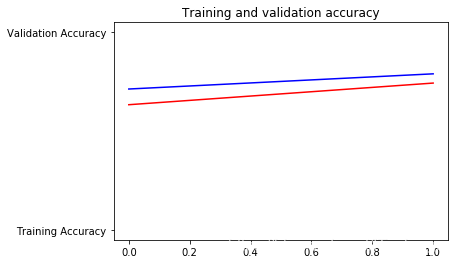
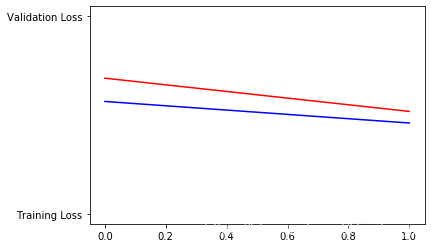
Figure size 432x288 with 0 Axes
5.10 model reasoning
# Here's a codeblock just for fun. You should be able to upload an image here
# and have it classified without crashing
import numpy as np
from google.colab import files
from keras.preprocessing import image
uploaded = files.upload()
for fn in uploaded.keys():
# predicting images
path = '/content/' + fn
img = image.load_img(path, target_size=(150, 150))
x = image.img_to_array(img)
x = np.expand_dims(x, axis=0)
images = np.vstack([x])
classes = model.predict(images, batch_size=10)
print(classes[0])
if classes[0]>0.5:
print(fn + " is a dog")
else:
print(fn + " is a cat")6. Transfer learning -- a case of human horse classification
6.1 downloading data sets
# https://storage.googleapis.com/laurencemoroney-blog.appspot.com/horse-or-human.zip(142.65M)
6.2 import library
import os import zipfile import matplotlib.pyplot as plt import matplotlib.image as mpimg
6.3 samples shall be classified and stored in the designated folder
local_zip = '/home/zzr/data/horse-or-human.zip'
zip_ref = zipfile.ZipFile(local_zip, 'r')
zip_ref.extractall('/home/zzr/data/zzr-tensorflow-person-horse')
zip_ref.close()
# Directory with our training horse pictures
train_horse_dir = os.path.join('/home/zzr/data/zzr-tensorflow-person-horse/horses')
# Directory with our training human pictures
train_human_dir = os.path.join('/home/zzr/data/zzr-tensorflow-person-horse/humans')6.4 read the data of 10 people and horses respectively under the stored directory folder
train_horse_names = os.listdir(train_horse_dir) print(train_horse_names[:10]) train_human_names = os.listdir(train_human_dir) print(train_human_names[:10])
['horse31-8.png', 'horse49-1.png', 'horse26-2.png', 'horse46-5.png', 'horse30-9.png', 'horse09-0.png', 'horse47-8.png', 'horse45-6.png', 'horse34-3.png', 'horse11-0.png'] ['human15-13.png', 'human07-27.png', 'human08-05.png', 'human01-05.png', 'human10-03.png', 'human02-13.png', 'human08-19.png', 'human01-19.png', 'human17-11.png', 'human09-18.png']
6.5 view the number of samples under the people and horses folder
print('total training horse images:', len(os.listdir(train_horse_dir)))
print('total training human images:', len(os.listdir(train_human_dir)))total training horse images: 500 total training human images: 527
6.6 use matplotlib to display the horse image
%matplotlib inline
# Parameters for our graph; we'll output images in a 4x4 configuration
nrows = 4
ncols = 4
# Index for iterating over images
pic_index = 0
# Set up matplotlib fig, and size it to fit 4x4 pics
fig = plt.gcf()
fig.set_size_inches(ncols * 4, nrows * 4)
pic_index += 8
next_horse_pix = [os.path.join(train_horse_dir, fname)
for fname in train_horse_names[pic_index-8:pic_index]]
next_human_pix = [os.path.join(train_human_dir, fname)
for fname in train_human_names[pic_index-8:pic_index]]
for i, img_path in enumerate(next_horse_pix+next_human_pix):
# Set up subplot; subplot indices start at 1
sp = plt.subplot(nrows, ncols, i + 1)
sp.axis('Off') # Don't show axes (or gridlines)
img = mpimg.imread(img_path)
plt.imshow(img)
plt.show()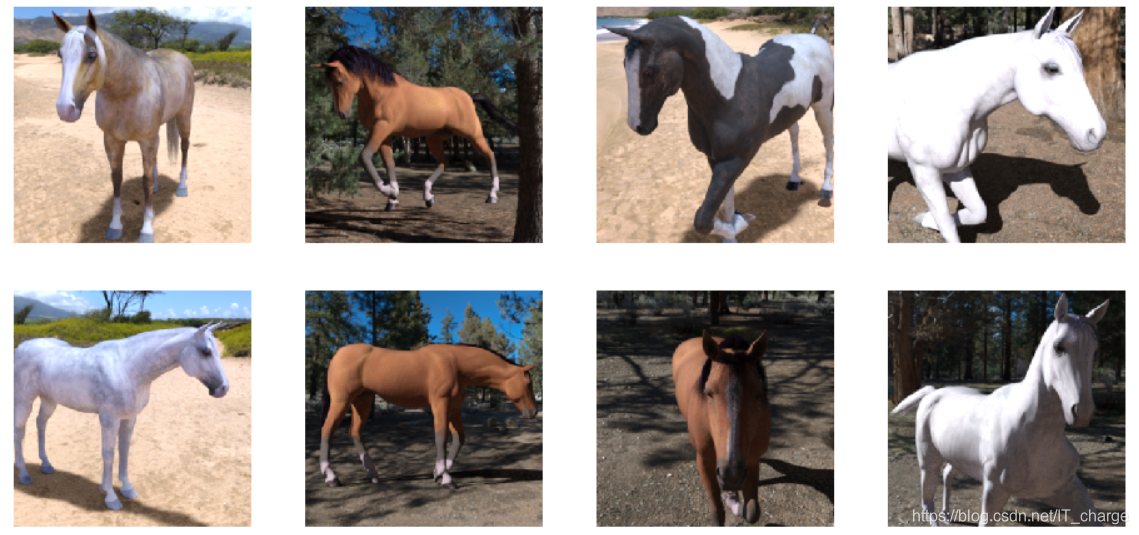
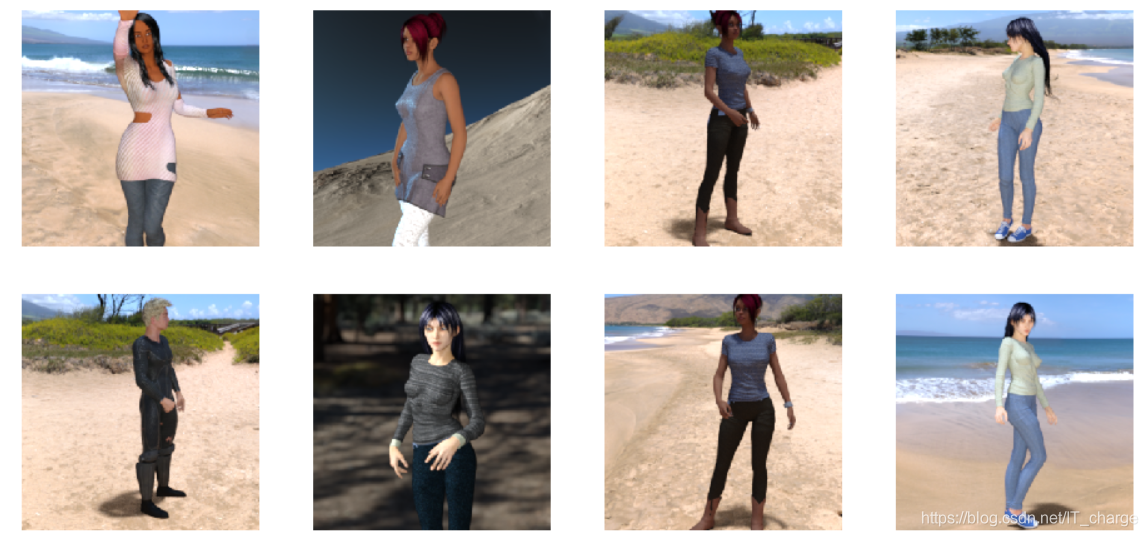
6.7 network construction and related parameters
import tensorflow as tf from tensorflow.keras.optimizers import RMSprop
model = tf.keras.models.Sequential([
# Note the input shape is the desired size of the image 300x300 with 3 bytes color
# This is the first convolution
tf.keras.layers.Conv2D(16, (3,3), activation='relu', input_shape=(300, 300, 3)),
tf.keras.layers.MaxPooling2D(2, 2),
# The second convolution
tf.keras.layers.Conv2D(32, (3,3), activation='relu'),
tf.keras.layers.MaxPooling2D(2,2),
# The third convolution
tf.keras.layers.Conv2D(64, (3,3), activation='relu'),
tf.keras.layers.MaxPooling2D(2,2),
# The fourth convolution
tf.keras.layers.Conv2D(64, (3,3), activation='relu'),
tf.keras.layers.MaxPooling2D(2,2),
# The fifth convolution
tf.keras.layers.Conv2D(64, (3,3), activation='relu'),
tf.keras.layers.MaxPooling2D(2,2),
# Flatten the results to feed into a DNN
tf.keras.layers.Flatten(),
# 512 neuron hidden layer
tf.keras.layers.Dense(512, activation='relu'),
# Only 1 output neuron. It will contain a value from 0-1 where 0 for 1 class ('horses') and 1 for the other ('humans')
tf.keras.layers.Dense(1, activation='sigmoid')
])
model.summary()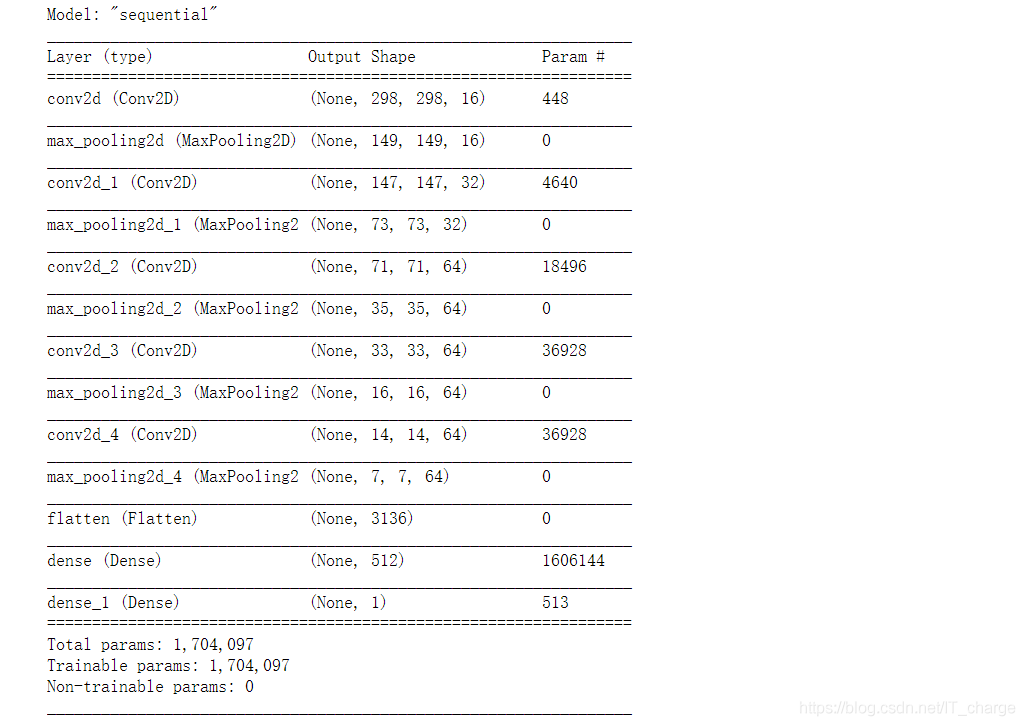
model.compile(loss='binary_crossentropy',
optimizer=RMSprop(lr=0.001),
metrics=['acc'])6.8 data preprocessing
from tensorflow.keras.preprocessing.image import ImageDataGenerator
# All images will be rescaled by 1./255
train_datagen = ImageDataGenerator(rescale=1/255)
# Flow training images in batches of 128 using train_datagen generator
train_generator = train_datagen.flow_from_directory(
'/home/zzr/data/zzr-tensorflow-person-horse/', # This is the source directory for training images
target_size=(300, 300), # All images will be resized to 150x150
batch_size=128,
# Since we use binary_crossentropy loss, we need binary labels
class_mode='binary')Found 1027 images belonging to 2 classes.
6.9 training network
history = model.fit_generator(
train_generator,
steps_per_epoch=8,
epochs=10,
verbose=1)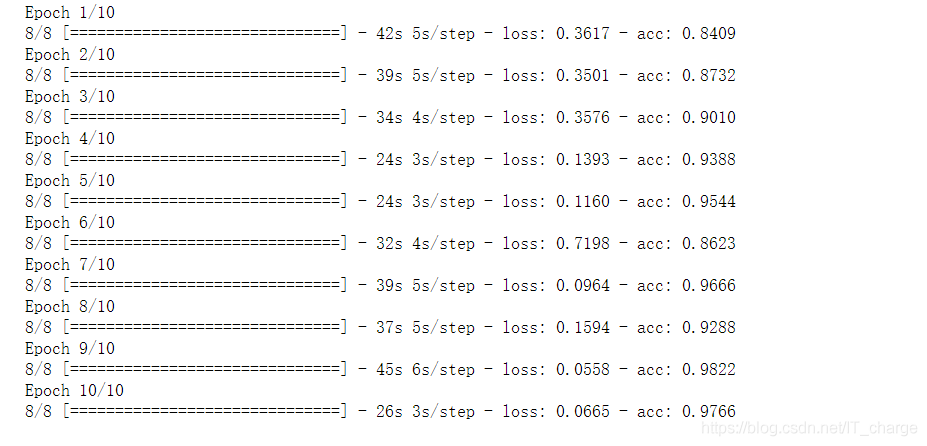
6.10 model evaluation
import numpy as np
from google.colab import files
from keras.preprocessing import image
uploaded = files.upload()
for fn in uploaded.keys():
# predicting images
path = '/home/zzr/picture/' + fn
img = image.load_img(path, target_size=(300, 300))
x = image.img_to_array(img)
x = np.expand_dims(x, axis=0)
images = np.vstack([x])
classes = model.predict(images, batch_size=10)
print(classes[0])
if classes[0]>0.5:
print(fn + " is a human")
else:
print(fn + " is a horse")6.11 view characteristic diagram
import numpy as np import random from tensorflow.keras.preprocessing.image import img_to_array, load_img
# Let's define a new Model that will take an image as input, and will output
# intermediate representations for all layers in the previous model after
# the first.
successive_outputs = [layer.output for layer in model.layers[1:]]
#visualization_model = Model(img_input, successive_outputs)
visualization_model = tf.keras.models.Model(inputs = model.input, outputs = successive_outputs)
# Let's prepare a random input image from the training set.
horse_img_files = [os.path.join(train_horse_dir, f) for f in train_horse_names]
human_img_files = [os.path.join(train_human_dir, f) for f in train_human_names]
img_path = random.choice(horse_img_files + human_img_files)
img = load_img(img_path, target_size=(300, 300)) # this is a PIL image
x = img_to_array(img) # Numpy array with shape (150, 150, 3)
x = x.reshape((1,) + x.shape) # Numpy array with shape (1, 150, 150, 3)
# Rescale by 1/255
x /= 255
# Let's run our image through our network, thus obtaining all
# intermediate representations for this image.
successive_feature_maps = visualization_model.predict(x)
# These are the names of the layers, so can have them as part of our plot
layer_names = [layer.name for layer in model.layers]
# Now let's display our representations
for layer_name, feature_map in zip(layer_names, successive_feature_maps):
if len(feature_map.shape) == 4:
# Just do this for the conv / maxpool layers, not the fully-connected layers
n_features = feature_map.shape[-1] # number of features in feature map
# The feature map has shape (1, size, size, n_features)
size = feature_map.shape[1]
# We will tile our images in this matrix
display_grid = np.zeros((size, size * n_features))
for i in range(n_features):
# Postprocess the feature to make it visually palatable
x = feature_map[0, :, :, i]
x -= x.mean()
x /= x.std()
x *= 64
x += 128
x = np.clip(x, 0, 255).astype('uint8')
# We'll tile each filter into this big horizontal grid
display_grid[:, i * size : (i + 1) * size] = x
# Display the grid
scale = 20. / n_features
plt.figure(figsize=(scale * n_features, scale))
plt.title(layer_name)
plt.grid(False)
plt.imshow(display_grid, aspect='auto', cmap='viridis')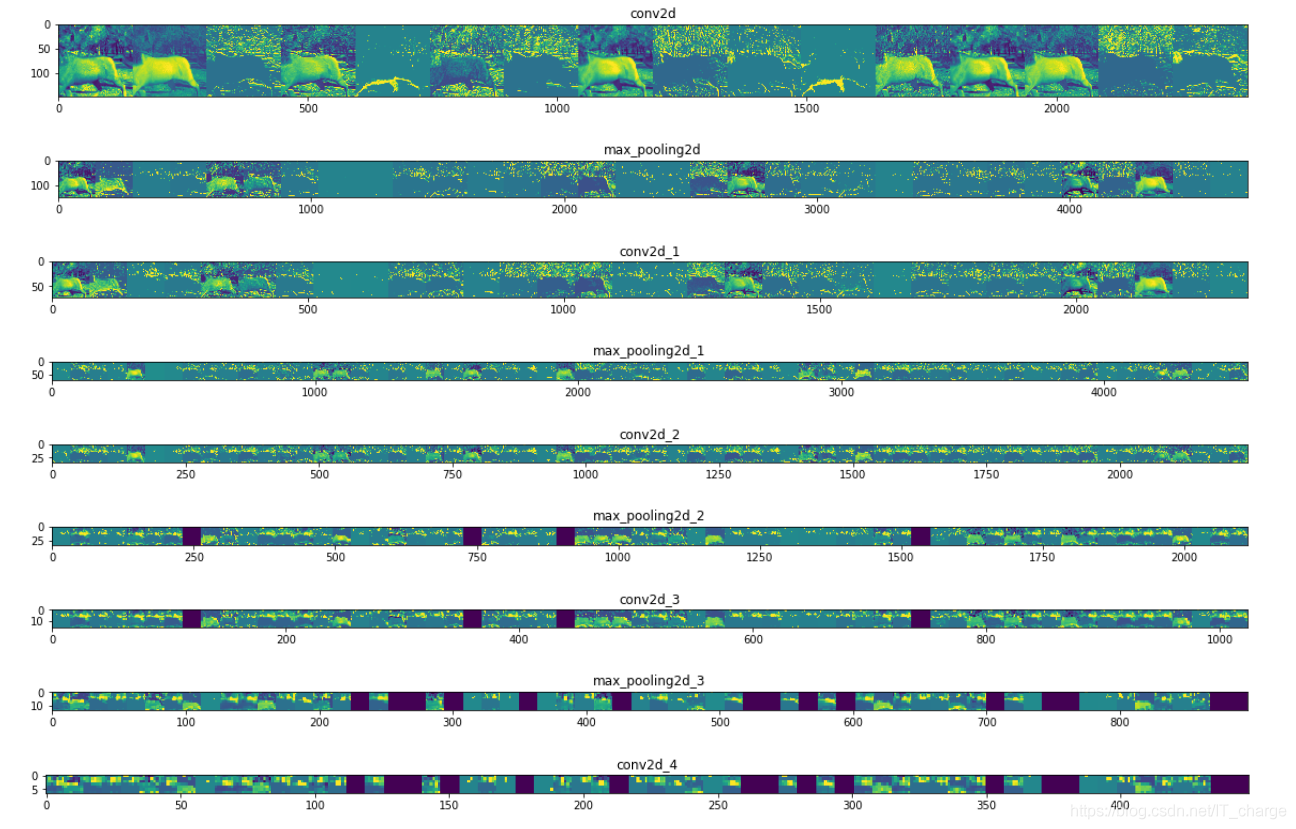
7 image multivariate classification -- a case of handwriting recognition
7.1 import and stock in
import csv import numpy as np import tensorflow as tf from tensorflow.keras.preprocessing.image import ImageDataGenerator from google.colab import files
# Load data uploaded = files.upload()
7.2 get data and view label size
def get_data(filename):
with open(filename) as training_file:
csv_reader = csv.reader(training_file, delimiter=',')
first_line = True
temp_images = []
temp_labels = []
for row in csv_reader:
if first_line:
# print("Ignoring first line")
first_line = False
else:
temp_labels.append(row[0])
image_data = row[1:785]
image_data_as_array = np.array_split(image_data, 28)
temp_images.append(image_data_as_array)
images = np.array(temp_images).astype('float')
labels = np.array(temp_labels).astype('float')
return images, labels
training_images, training_labels = get_data('/home/zzr/data/sign_mnist_train.csv')
testing_images, testing_labels = get_data('/home/zzr/data/sign_mnist_test.csv')
print(training_images.shape)
print(training_labels.shape)
print(testing_images.shape)
print(testing_labels.shape)(27455, 28, 28) (27455,) (7172, 28, 28) (7172,)
7.3 data enhancement processing
training_images = np.expand_dims(training_images, axis=3)
testing_images = np.expand_dims(testing_images, axis=3)
train_datagen = ImageDataGenerator(
rescale=1. / 255,
rotation_range=40,
width_shift_range=0.2,
height_shift_range=0.2,
shear_range=0.2,
zoom_range=0.2,
horizontal_flip=True,
fill_mode='nearest')
validation_datagen = ImageDataGenerator(
rescale=1. / 255)
print(training_images.shape)
print(testing_images.shape)(27455, 28, 28, 1) (7172, 28, 28, 1)
7.4 model construction
model = tf.keras.models.Sequential([
tf.keras.layers.Conv2D(64, (3, 3), activation='relu', input_shape=(28, 28, 1)),
tf.keras.layers.MaxPooling2D(2, 2),
tf.keras.layers.Conv2D(64, (3, 3), activation='relu'),
tf.keras.layers.MaxPooling2D(2, 2),
tf.keras.layers.Flatten(),
tf.keras.layers.Dense(128, activation=tf.nn.relu),
tf.keras.layers.Dense(26, activation=tf.nn.softmax)])
# After modification
model.compile(optimizer = tf.optimizers.Adam(),
loss = 'sparse_categorical_crossentropy',
metrics=['accuracy'])7.5 model training + evaluation
history = model.fit_generator(train_datagen.flow(training_images, training_labels, batch_size=32),
steps_per_epoch=len(training_images) / 32,
epochs=10,
validation_data=validation_datagen.flow(testing_images, testing_labels, batch_size=32),
validation_steps=len(testing_images) / 32)
# assessment
model.evaluate(testing_images, testing_labels)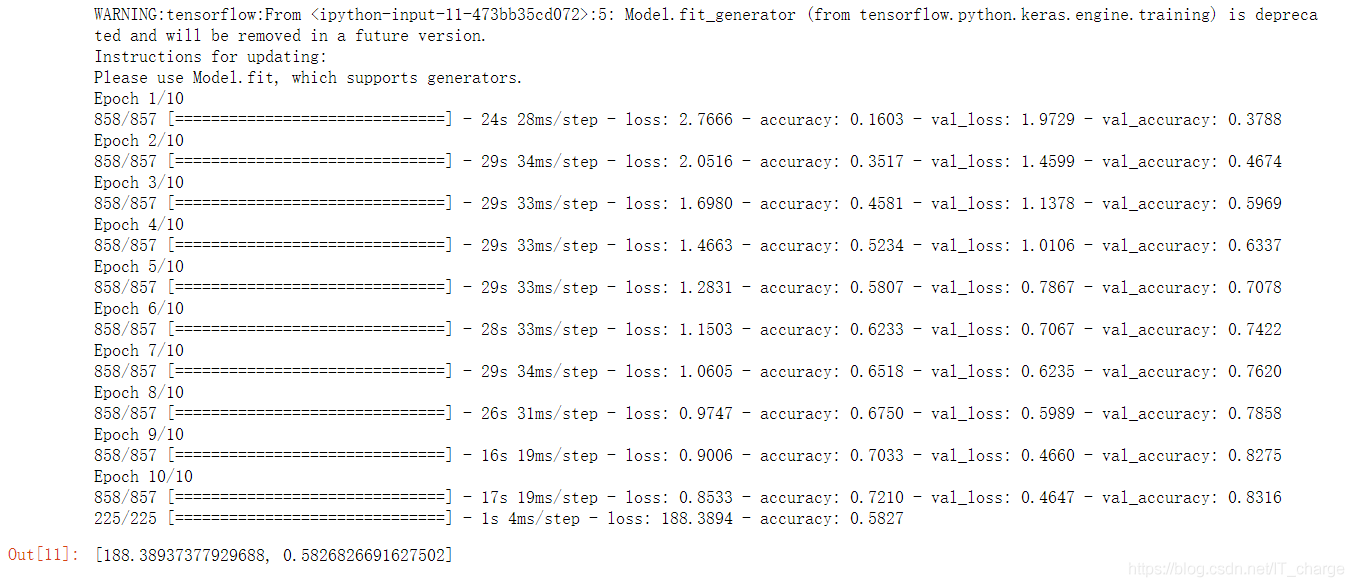
7.6 visual network results
import matplotlib.pyplot as plt
acc = history.history['accuracy']
val_acc = history.history['val_accuracy']
loss = history.history['loss']
val_loss = history.history['val_loss']
epochs = range(len(acc))
plt.plot(epochs, acc, 'r', label='Training accuracy')
plt.plot(epochs, val_acc, 'b', label='Validation accuracy')
plt.title('Training and validation accuracy')
plt.legend()
plt.figure()
plt.plot(epochs, loss, 'r', label='Training Loss')
plt.plot(epochs, val_loss, 'b', label='Validation Loss')
plt.title('Training and validation loss')
plt.legend()
plt.show()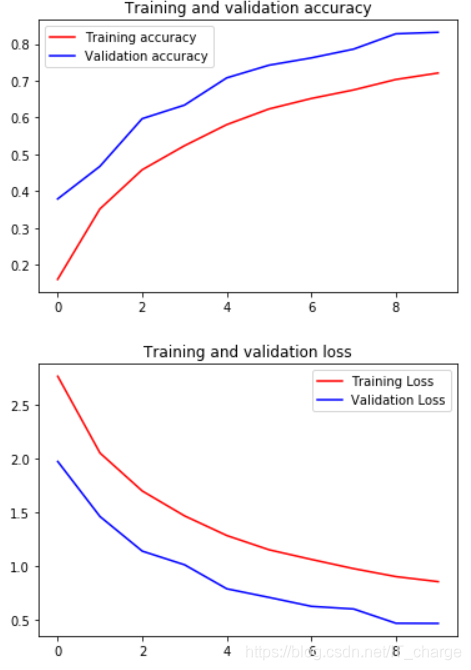
8 image multivariate classification -- gesture recognition of scissors, stone and cloth
8.1 downloading data sets
!wget --no-check-certificate \
https://storage.googleapis.com/laurencemoroney-blog.appspot.com/rps.zip \
-O /tmp/rps.zip!wget --no-check-certificate \
https://storage.googleapis.com/laurencemoroney-blog.appspot.com/rps-test-set.zip \
-O /tmp/rps-test-set.zip8.2 guide library
import os import zipfile import matplotlib.pyplot as plt import matplotlib.image as mpimg import tensorflow as tf import numpy as np from google.colab import files from keras.preprocessing import image import keras_preprocessing from keras_preprocessing import image from keras_preprocessing.image import ImageDataGenerator
8.3 viewing the number of samples
rock_dir = os.path.join('/home/zzr/data/rps/rock')
paper_dir = os.path.join('/home/zzr/data/rps/paper')
scissors_dir = os.path.join('/home/zzr/data/rps/scissors')
print('total training rock images:', len(os.listdir(rock_dir)))
print('total training paper images:', len(os.listdir(paper_dir)))
print('total training scissors images:', len(os.listdir(scissors_dir)))
rock_files = os.listdir(rock_dir)
print(rock_files[:10])
paper_files = os.listdir(paper_dir)
print(paper_files[:10])
scissors_files = os.listdir(scissors_dir)
print(scissors_files[:10])total training rock images: 840 total training paper images: 840 total training scissors images: 840 ['rock02-070.png', 'rock06ck02-055.png', 'rock06ck02-070.png', 'rock07-k03-096.png', 'rock02-037.png', 'rock05ck01-066.png', 'rock02-034.png', 'rock05ck01-031.png', 'rock06ck02-094.png', 'rock02-060.png'] ['paper02-037.png', 'paper01-076.png', 'paper04-074.png', 'paper05-039.png', 'paper05-062.png', 'paper01-075.png', 'paper04-113.png', 'paper05-069.png', 'paper04-111.png', 'paper03-100.png'] ['testscissors02-006.png', 'scissors04-100.png', 'testscissors01-032.png', 'scissors03-074.png', 'testscissors02-024.png', 'scissors03-089.png', 'scissors04-020.png', 'scissors04-024.png', 'testscissors02-081.png', 'scissors01-035.png']
8.4 visual samples
%matplotlib inline
pic_index = 2
next_rock = [os.path.join(rock_dir, fname)
for fname in rock_files[pic_index-2:pic_index]]
next_paper = [os.path.join(paper_dir, fname)
for fname in paper_files[pic_index-2:pic_index]]
next_scissors = [os.path.join(scissors_dir, fname)
for fname in scissors_files[pic_index-2:pic_index]]
for i, img_path in enumerate(next_rock+next_paper+next_scissors):
print(img_path)
img = mpimg.imread(img_path)
plt.imshow(img)
plt.axis('Off')
plt.show()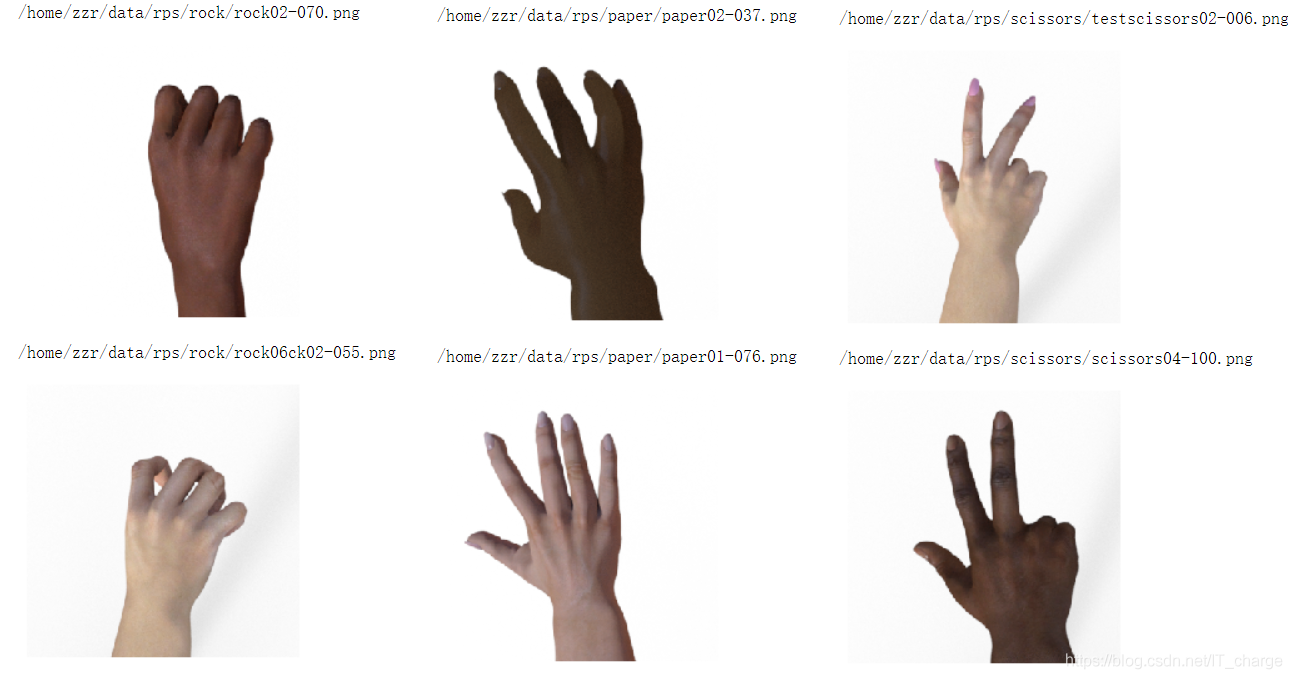
8.5 data enhancement, network building and training
TRAINING_DIR = "/home/zzr/data/rps/"
training_datagen = ImageDataGenerator(
rescale = 1./255,
rotation_range=40,
width_shift_range=0.2,
height_shift_range=0.2,
shear_range=0.2,
zoom_range=0.2,
horizontal_flip=True,
fill_mode='nearest')
VALIDATION_DIR = "/home/zzr/data/rps-test-set/"
validation_datagen = ImageDataGenerator(rescale = 1./255)
train_generator = training_datagen.flow_from_directory(
TRAINING_DIR,
target_size=(150,150),
class_mode='categorical'
)
validation_generator = validation_datagen.flow_from_directory(
VALIDATION_DIR,
target_size=(150,150),
class_mode='categorical'
)
model = tf.keras.models.Sequential([
# Note the input shape is the desired size of the image 150x150 with 3 bytes color
# This is the first convolution
tf.keras.layers.Conv2D(64, (3,3), activation='relu', input_shape=(150, 150, 3)),
tf.keras.layers.MaxPooling2D(2, 2),
# The second convolution
tf.keras.layers.Conv2D(64, (3,3), activation='relu'),
tf.keras.layers.MaxPooling2D(2,2),
# The third convolution
tf.keras.layers.Conv2D(128, (3,3), activation='relu'),
tf.keras.layers.MaxPooling2D(2,2),
# The fourth convolution
tf.keras.layers.Conv2D(128, (3,3), activation='relu'),
tf.keras.layers.MaxPooling2D(2,2),
# Flatten the results to feed into a DNN
tf.keras.layers.Flatten(),
tf.keras.layers.Dropout(0.5),
# 512 neuron hidden layer
tf.keras.layers.Dense(512, activation='relu'),
tf.keras.layers.Dense(3, activation='softmax')
])
model.summary()
model.compile(loss = 'categorical_crossentropy', optimizer='rmsprop', metrics=['accuracy'])
history = model.fit_generator(train_generator, epochs=10, validation_data = validation_generator, verbose = 1)
model.save("/home/zzr/data/rps.h5")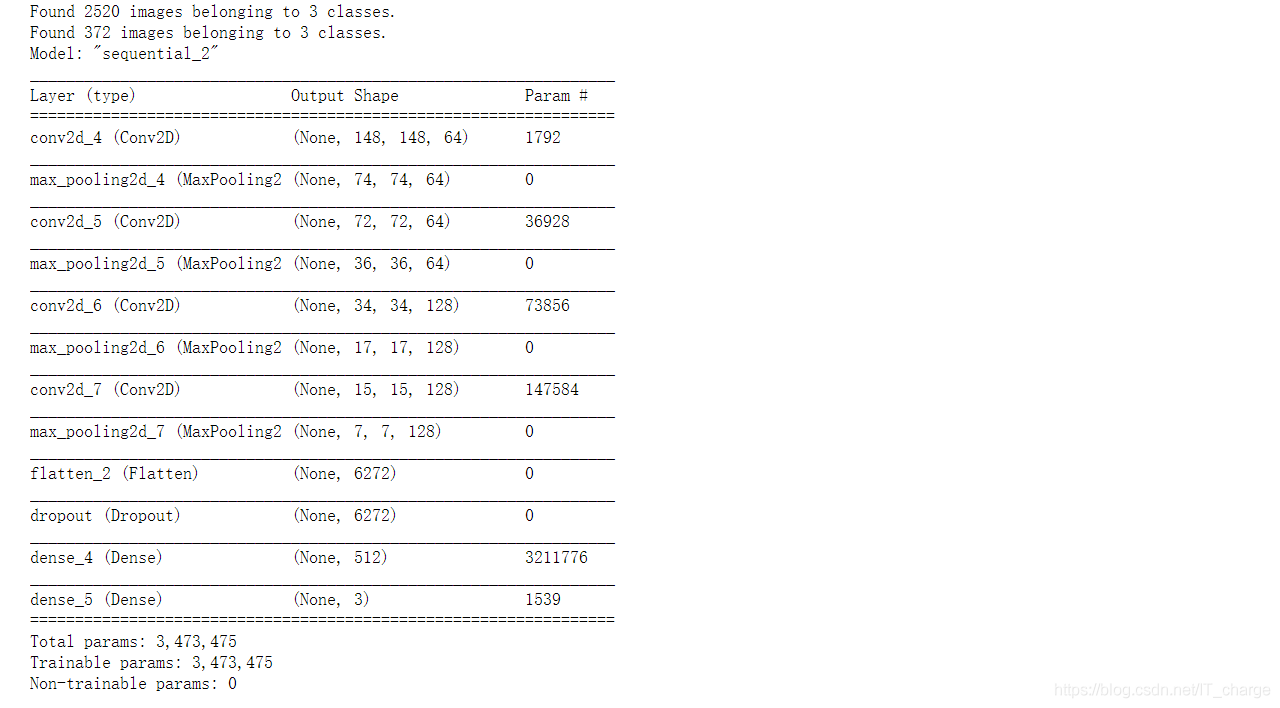
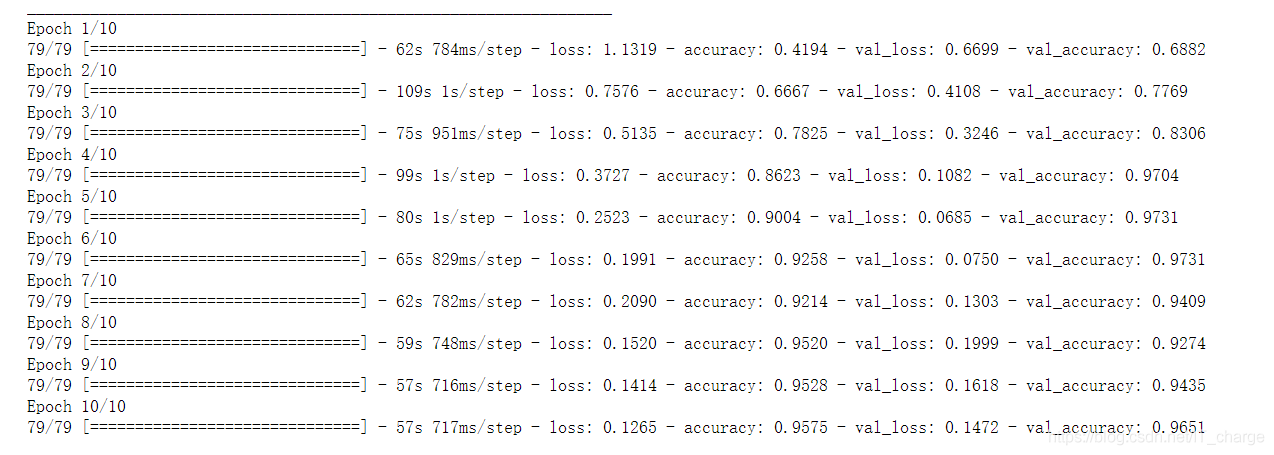
8.6 visual training model
acc = history.history['accuracy']
val_acc = history.history['val_accuracy']
loss = history.history['loss']
val_loss = history.history['val_loss']
epochs = range(len(acc))
plt.plot(epochs, acc, 'r', label='Training accuracy')
plt.plot(epochs, val_acc, 'b', label='Validation accuracy')
plt.title('Training and validation accuracy')
plt.legend(loc=0)
plt.figure()
plt.show()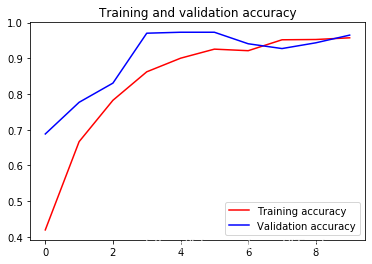
Figure size 432x288 with 0 Axes
8.7 model evaluation
# Data loading uploaded = files.upload()
# forecast
for fn in uploaded.keys():
# predicting images
path = fn
img = image.load_img(path, target_size=(150, 150))
x = image.img_to_array(img)
x = np.expand_dims(x, axis=0)
images = np.vstack([x])
classes = model.predict(images, batch_size=10)
print(fn)
print(classes)9 natural language processing
9 entry and serialization
9.1 entry - basic principle of word splitter
from tensorflow.keras.preprocessing.text import Tokenizer
sentences = [
'i love my dog',
'I, love my cat'
]tokenizer = Tokenizer(num_words = 100) tokenizer.fit_on_texts(sentences) word_index = tokenizer.word_index print(word_index)
{'i': 1, 'love': 2, 'my': 3, 'dog': 4, 'cat': 5}
sentences = [
'i love my dog',
'I, love my cat',
'You love my dog!'
]tokenizer = Tokenizer(num_words = 100) tokenizer.fit_on_texts(sentences) word_index = tokenizer.word_index print(word_index)
{'love': 1, 'my': 2, 'i': 3, 'dog': 4, 'cat': 5, 'you': 6}
9.2 serialized sentences
import tensorflow as tf
from tensorflow import keras
from tensorflow.keras.preprocessing.text import Tokenizer
from tensorflow.keras.preprocessing.sequence import pad_sequences
sentences = [
'I love my dog',
'I love my cat',
'You love my dog!',
'Do you think my dog is amazing?'
]
tokenizer = Tokenizer(num_words = 100, oov_token="<OOV>")
tokenizer.fit_on_texts(sentences)
word_index = tokenizer.word_index
sequences = tokenizer.texts_to_sequences(sentences)
padded = pad_sequences(sequences,maxlen = 8)
print("\nWord Index = " , word_index)
print("\nSequences = " , sequences)
print("\nPadded Sequences:")
print(padded)
# Try with words that the tokenizer wasn't fit to
test_data = [
'i really love my dog',
'my dog loves my manatee'
]
test_seq = tokenizer.texts_to_sequences(test_data)
print("\nTest Sequence = ", test_seq)
padded = pad_sequences(test_seq,maxlen = 5)
print("\nPadded Test Sequence: ")
print(padded)
9.3 project practice -- entry and serialization of satirical data sets
# https://storage.googleapis.com/laurencemoroney-blog.appspot.com/sarcasm.json
import json
with open("/home/zzr/data/sarcasm.json", 'r') as f:
datastore = json.load(f)
sentences = []
labels = []
urls = []
for item in datastore:
sentences.append(item['headline'])
labels.append(item['is_sarcastic'])
urls.append(item['article_link'])
from tensorflow.keras.preprocessing.text import Tokenizer
from tensorflow.keras.preprocessing.sequence import pad_sequences
tokenizer = Tokenizer(oov_token="<OOV>")
tokenizer.fit_on_texts(sentences)
word_index = tokenizer.word_index
print(len(word_index))
print(word_index)
sequences = tokenizer.texts_to_sequences(sentences)
padded = pad_sequences(sequences, padding='post')
print(sentences[2])
print(padded[2])
print(padded.shape)29657 {’’: 1, ‘to’: 2, ‘of’: 3, ‘the’: 4, ‘in’: 5, ‘for’: 6, ‘a’: 7, ‘on’: 8, ‘and’: 9, ‘with’: 10, ‘is’: 11, ‘new’: 12, ‘trump’: 13, ‘man’: 14, ‘from’: 15, ‘at’: 16, ‘about’: 17, ‘you’: 18, ‘this’: 19, ‘by’: 20, ‘after’: 21, ‘up’: 22, ‘out’: 23, ‘be’: 24, ‘how’: 25, ‘as’: 26, ‘it’: 27, ‘that’: 28, ‘not’: 29, ‘are’: 30, ‘your’: 31, ‘his’: 32, ‘what’: 33, ‘he’: 34, ‘all’: 35, ‘just’: 36, ‘who’: 37, ‘has’: 38, ‘will’: 39, ‘more’: 40, ‘one’: 41, ‘into’: 42, ‘report’: 43, ‘year’: 44, ‘why’: 45, ‘have’: 46, ‘area’: 47, ‘over’: 48, ‘donald’: 49, ‘u’: 50, ‘day’: 51, ‘says’: 52, ‘s’: 53, ‘can’: 54, ‘first’: 55, ‘woman’: 56, ‘time’: 57, ‘like’: 58, ‘her’: 59, “trump’s”: 60, ‘old’: 61, ‘no’: 62, ‘get’: 63, ‘off’: 64, ‘an’: 65, ‘life’: 66, ‘people’: 67, ‘obama’: 68, 'now': 69, 'house': 70, 'still': 71, '' ': 72,' women ': 73,' make ': 74,' was': 75, 'than': 76, 'white': 77... (omitting a lot)... 'zimbabwe's': 29651,' gonzalez ': 29652,' breaded ': 29653,' 'basic': 29654, 'horses': 29655,' gourmet ': 29656,' foodie ': 29657} mom starting to fear son's web series closest thing she will have to grandchild [ 145 838 2 907 1749 2093 582 4719 221 143 39 46 2 10736 0 0 0 0 0 0 0 0 0 0 0 0 0 0 0 0 0 0 0 0 0 0 0 0 0 0] (26709, 40)